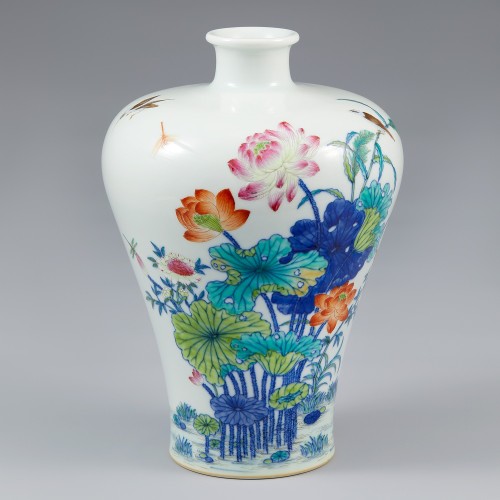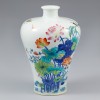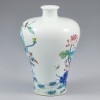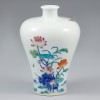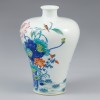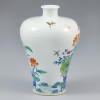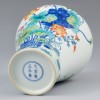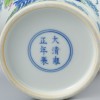본문
분채(粉彩) 기법으로 연못의 아름다운 풍경이 그려진 매병입니다.
잔잔한 연못 위로 탐스러운 연꽃이 우아하게 피어 있으며, 연잎들은 부드럽게 너울대며 자연스럽게 끝이 말려 조화를 이루고 있습니다. 긴 부리를 지닌 물총새는 우아한 자태로 연꽃 위에 앉아 있거나 하늘을 날고 있으며, 그 곁에 잠자리가 연꽃 봉오리 주변이나 하늘을 가로지르고 있습니다. 특히 날개의 깃털은 섬세하고 선명하게 표현되어 있어 정교함이 돋보입니다. 이 문양은 분채 기법으로 그려졌으며, 화려한 색감이 두드러져 더욱 생동감이 느껴집니다.
연꽃은 순결, 고결, 상서로움을 상징하는 대표적인 길상(吉祥) 소재입니다. 물총새는 흔히 행복의 파랑새로 불리며, 행운, 애정, 충절을 상징합니다. 또한, 물고기 사냥의 왕이라 불리기도 하는데, 총알처럼 빠른 속도로 물속에 뛰어들어 사냥하는 모습에서 이러한 별명이 유래했습니다. 연꽃과 물총새가 함께 그려진 문양은 "백년해로(百年偕老)", 즉 한결같고 변치 않는 사랑을 뜻하는 길상의 의미를 담고 있습니다.
굽바닥에는 이 유물이 청나라 옹정 시기(雍正, 1723~1735)의 유물임을 나타내는 '大清雍正年製(대청옹정년제)' 관지가 새겨져 있습니다.
梅瓶以粉彩技法描绘池塘的美丽景色。
平静的池塘中,荷花优雅地绽放,荷叶轻轻摇曳,末端自然卷曲,展现出和谐的美感。一只长喙的翠鸟优雅地栖息在荷花上,或在天空中飞翔,而附近的蜻蜓则在花苞周围或在天空中飞舞。特别是它的羽毛细致而清晰,展现了精致的工艺。此图案采用粉彩技法,鲜艳的色彩使得画面更具生动感。
荷花象征纯洁、高贵和吉祥。翠鸟通常被称为幸福的蓝鸟,象征幸运、爱情和忠诚。此外,它也被称为捕鱼之王,因为它能像子弹一样迅速跳入水中捕捉鱼类。荷花与翠鸟一起的图案寓意着“百年偕老”,象征着长久且不变的爱情。
瓶底署“大清雍正年制”款识,可知是清代雍正时期(1723-1735年)的作品。
This is a Meiping vase decorated with a beautiful pond scene using the Famille Rose (粉彩) technique.
Above the tranquil pond, lush lotus flowers bloom elegantly, while lotus leaves gently sway, their curled edges adding a natural sense of movement. A kingfisher, with its slender beak and graceful posture, perches atop a lotus flower or soars through the sky, while a dragonfly flits around the lotus buds or hovers in the air. The delicate and vivid depiction of the birds' feathers showcases the exquisite craftsmanship. The Famille Rose technique enhances the vibrancy of the colors, bringing the scene to life with exceptional dynamism.
The lotus flower is a classic auspicious motif symbolizing purity, nobility, and good fortune. The kingfisher, often called the "bluebird of happiness," represents luck, love, and loyalty. Known as the "king of fish hunters," it is famous for its remarkable speed, diving into the water like a bullet to catch prey. The combination of lotus flowers and kingfishers carries the symbolic meaning of "bainian daolao (白年到老),” an idiom referring to a steadfast and enduring love.
On the base of the vase, there is an imperial reign mark reading "大清雍正年製" (Made during the Yongzheng reign of the Great Qing)," indicating that this piece was produced during the Yongzheng period (1723–1735) of the Qing Dynasty.
